Astronomy Assignment: The Formation of Saturn's Rings
VerifiedAdded on 2022/11/24
|6
|1253
|420
Report
AI Summary
This report provides a comprehensive overview of Saturn's rings, detailing their composition, structure, and formation. It begins by highlighting the rings' prevalence in the solar system, composed primarily of water ice and rocky material, and discusses the ongoing debate regarding their origin. The report traces the history of their discovery, from Galileo Galilei's initial observations to Christiaan Huygens's description as a disk. It delves into various theories of formation, including the violent origins from the early solar system, the role of tidal forces, and the potential disruption of icy moons. The report also explores the rings' composition, physical properties, and the influence of Saturn's moons on their structure. Key aspects discussed include the size and density of Saturn, the speed of its rotation, and the materials found in the rings. The report concludes by referencing multiple studies, providing a solid foundation for understanding the rings' complexity and the ongoing research in this field.
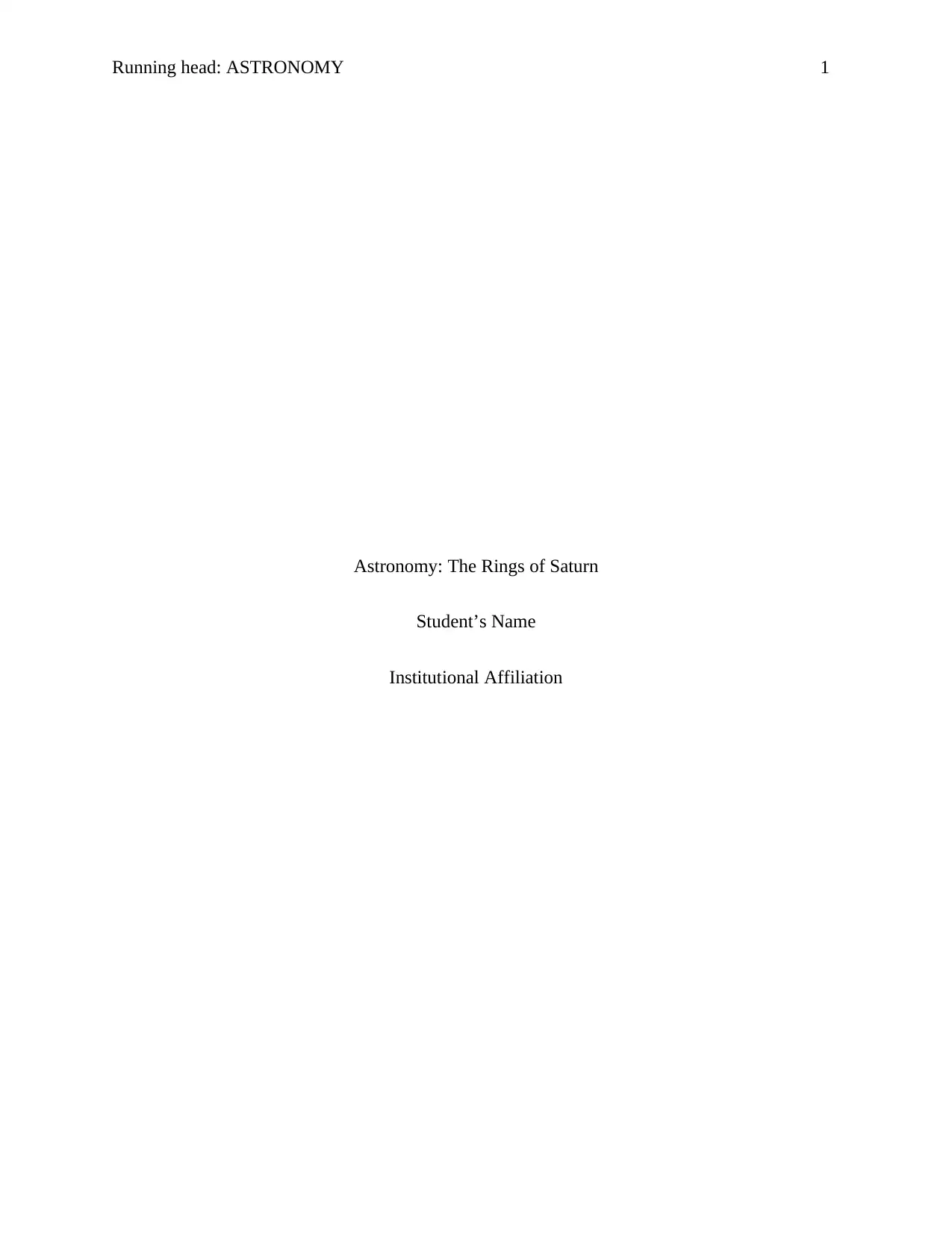
Running head: ASTRONOMY 1
Astronomy: The Rings of Saturn
Student’s Name
Institutional Affiliation
Astronomy: The Rings of Saturn
Student’s Name
Institutional Affiliation
Paraphrase This Document
Need a fresh take? Get an instant paraphrase of this document with our AI Paraphraser
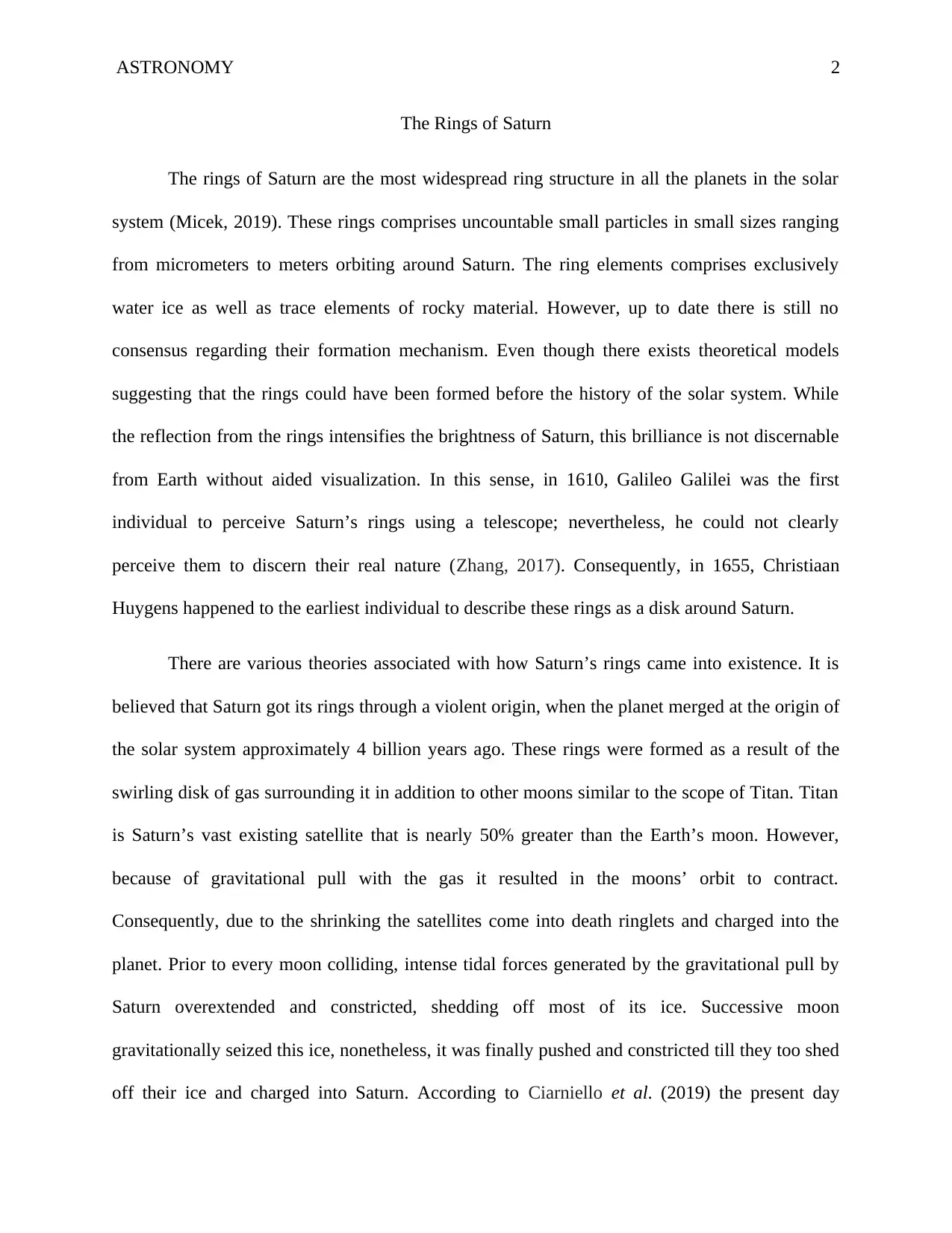
ASTRONOMY 2
The Rings of Saturn
The rings of Saturn are the most widespread ring structure in all the planets in the solar
system (Micek, 2019). These rings comprises uncountable small particles in small sizes ranging
from micrometers to meters orbiting around Saturn. The ring elements comprises exclusively
water ice as well as trace elements of rocky material. However, up to date there is still no
consensus regarding their formation mechanism. Even though there exists theoretical models
suggesting that the rings could have been formed before the history of the solar system. While
the reflection from the rings intensifies the brightness of Saturn, this brilliance is not discernable
from Earth without aided visualization. In this sense, in 1610, Galileo Galilei was the first
individual to perceive Saturn’s rings using a telescope; nevertheless, he could not clearly
perceive them to discern their real nature (Zhang, 2017). Consequently, in 1655, Christiaan
Huygens happened to the earliest individual to describe these rings as a disk around Saturn.
There are various theories associated with how Saturn’s rings came into existence. It is
believed that Saturn got its rings through a violent origin, when the planet merged at the origin of
the solar system approximately 4 billion years ago. These rings were formed as a result of the
swirling disk of gas surrounding it in addition to other moons similar to the scope of Titan. Titan
is Saturn’s vast existing satellite that is nearly 50% greater than the Earth’s moon. However,
because of gravitational pull with the gas it resulted in the moons’ orbit to contract.
Consequently, due to the shrinking the satellites come into death ringlets and charged into the
planet. Prior to every moon colliding, intense tidal forces generated by the gravitational pull by
Saturn overextended and constricted, shedding off most of its ice. Successive moon
gravitationally seized this ice, nonetheless, it was finally pushed and constricted till they too shed
off their ice and charged into Saturn. According to Ciarniello et al. (2019) the present day
The Rings of Saturn
The rings of Saturn are the most widespread ring structure in all the planets in the solar
system (Micek, 2019). These rings comprises uncountable small particles in small sizes ranging
from micrometers to meters orbiting around Saturn. The ring elements comprises exclusively
water ice as well as trace elements of rocky material. However, up to date there is still no
consensus regarding their formation mechanism. Even though there exists theoretical models
suggesting that the rings could have been formed before the history of the solar system. While
the reflection from the rings intensifies the brightness of Saturn, this brilliance is not discernable
from Earth without aided visualization. In this sense, in 1610, Galileo Galilei was the first
individual to perceive Saturn’s rings using a telescope; nevertheless, he could not clearly
perceive them to discern their real nature (Zhang, 2017). Consequently, in 1655, Christiaan
Huygens happened to the earliest individual to describe these rings as a disk around Saturn.
There are various theories associated with how Saturn’s rings came into existence. It is
believed that Saturn got its rings through a violent origin, when the planet merged at the origin of
the solar system approximately 4 billion years ago. These rings were formed as a result of the
swirling disk of gas surrounding it in addition to other moons similar to the scope of Titan. Titan
is Saturn’s vast existing satellite that is nearly 50% greater than the Earth’s moon. However,
because of gravitational pull with the gas it resulted in the moons’ orbit to contract.
Consequently, due to the shrinking the satellites come into death ringlets and charged into the
planet. Prior to every moon colliding, intense tidal forces generated by the gravitational pull by
Saturn overextended and constricted, shedding off most of its ice. Successive moon
gravitationally seized this ice, nonetheless, it was finally pushed and constricted till they too shed
off their ice and charged into Saturn. According to Ciarniello et al. (2019) the present day
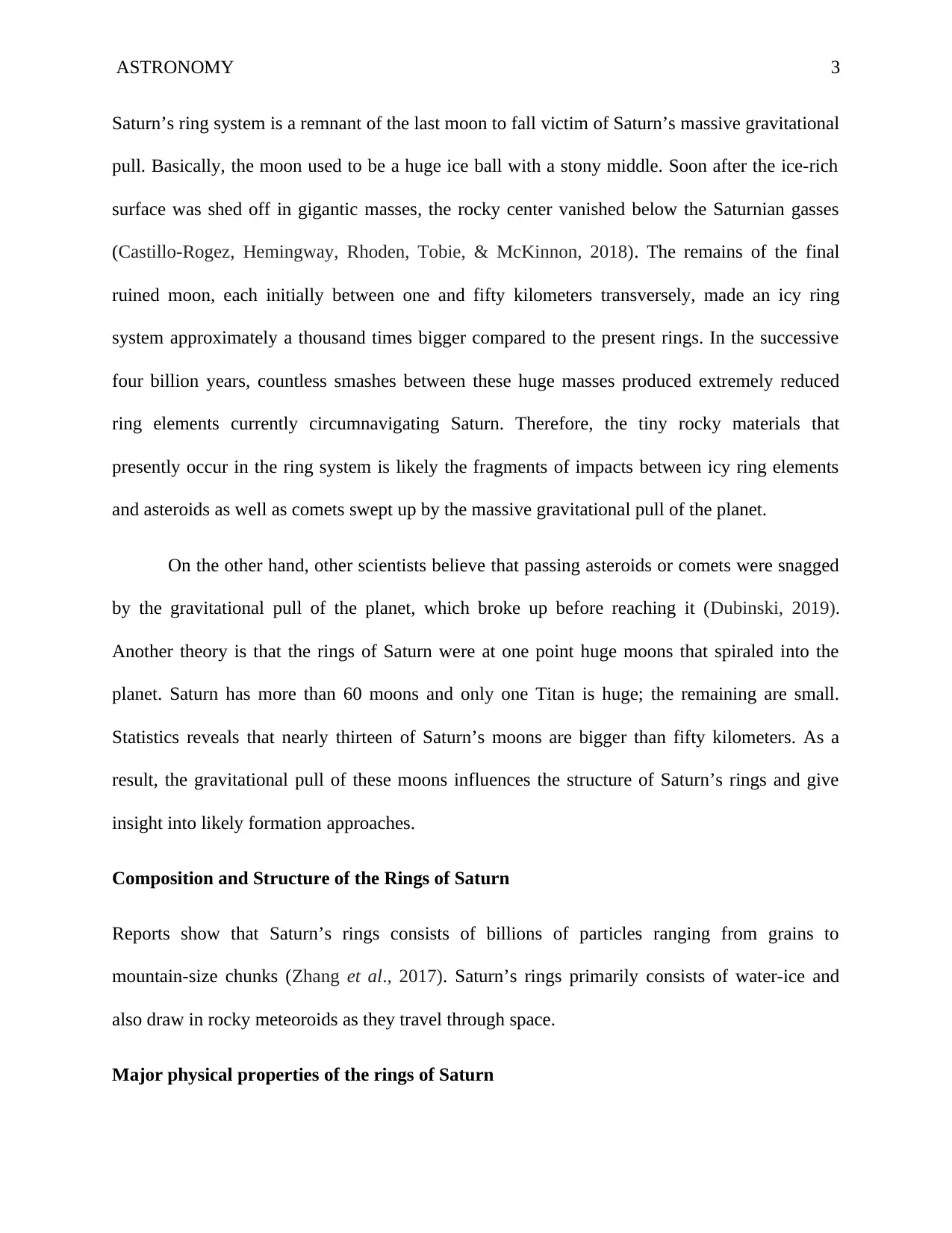
ASTRONOMY 3
Saturn’s ring system is a remnant of the last moon to fall victim of Saturn’s massive gravitational
pull. Basically, the moon used to be a huge ice ball with a stony middle. Soon after the ice-rich
surface was shed off in gigantic masses, the rocky center vanished below the Saturnian gasses
(Castillo-Rogez, Hemingway, Rhoden, Tobie, & McKinnon, 2018). The remains of the final
ruined moon, each initially between one and fifty kilometers transversely, made an icy ring
system approximately a thousand times bigger compared to the present rings. In the successive
four billion years, countless smashes between these huge masses produced extremely reduced
ring elements currently circumnavigating Saturn. Therefore, the tiny rocky materials that
presently occur in the ring system is likely the fragments of impacts between icy ring elements
and asteroids as well as comets swept up by the massive gravitational pull of the planet.
On the other hand, other scientists believe that passing asteroids or comets were snagged
by the gravitational pull of the planet, which broke up before reaching it (Dubinski, 2019).
Another theory is that the rings of Saturn were at one point huge moons that spiraled into the
planet. Saturn has more than 60 moons and only one Titan is huge; the remaining are small.
Statistics reveals that nearly thirteen of Saturn’s moons are bigger than fifty kilometers. As a
result, the gravitational pull of these moons influences the structure of Saturn’s rings and give
insight into likely formation approaches.
Composition and Structure of the Rings of Saturn
Reports show that Saturn’s rings consists of billions of particles ranging from grains to
mountain-size chunks (Zhang et al., 2017). Saturn’s rings primarily consists of water-ice and
also draw in rocky meteoroids as they travel through space.
Major physical properties of the rings of Saturn
Saturn’s ring system is a remnant of the last moon to fall victim of Saturn’s massive gravitational
pull. Basically, the moon used to be a huge ice ball with a stony middle. Soon after the ice-rich
surface was shed off in gigantic masses, the rocky center vanished below the Saturnian gasses
(Castillo-Rogez, Hemingway, Rhoden, Tobie, & McKinnon, 2018). The remains of the final
ruined moon, each initially between one and fifty kilometers transversely, made an icy ring
system approximately a thousand times bigger compared to the present rings. In the successive
four billion years, countless smashes between these huge masses produced extremely reduced
ring elements currently circumnavigating Saturn. Therefore, the tiny rocky materials that
presently occur in the ring system is likely the fragments of impacts between icy ring elements
and asteroids as well as comets swept up by the massive gravitational pull of the planet.
On the other hand, other scientists believe that passing asteroids or comets were snagged
by the gravitational pull of the planet, which broke up before reaching it (Dubinski, 2019).
Another theory is that the rings of Saturn were at one point huge moons that spiraled into the
planet. Saturn has more than 60 moons and only one Titan is huge; the remaining are small.
Statistics reveals that nearly thirteen of Saturn’s moons are bigger than fifty kilometers. As a
result, the gravitational pull of these moons influences the structure of Saturn’s rings and give
insight into likely formation approaches.
Composition and Structure of the Rings of Saturn
Reports show that Saturn’s rings consists of billions of particles ranging from grains to
mountain-size chunks (Zhang et al., 2017). Saturn’s rings primarily consists of water-ice and
also draw in rocky meteoroids as they travel through space.
Major physical properties of the rings of Saturn
⊘ This is a preview!⊘
Do you want full access?
Subscribe today to unlock all pages.

Trusted by 1+ million students worldwide

ASTRONOMY 4
Saturn is a gas giant, which consists majorly of helium and hydrogen. Saturn is the second
biggest planet. Research has shown that Saturn is big enough to hold more than 800 planets the
size of Earth (Arnault & Tiscareno, 2016). Similarly, Saturn is vaster as compared to any other
planet apart from Jupiter. While Saturn is nearly 100 times the mass of Earth, it has the lowest
density amongst all planets and it is the sole planet, which weighs less than water. Saturn has the
biggest ring that traverse approximately 200 times the diameter of the planet (Perkins, 2010).
Saturn is the fastest planet from Earths visibility with gold and yellow bands that are visible in
the planet’s atmosphere that are because of the super-fast winds in the upper atmosphere. As a
result of the faster spinning speed of Saturn and high centrifugal force the denser materials on its
surface like heavy gases, dust and magma vapor are projected out to form dynamic rings.
Saturn is a gas giant, which consists majorly of helium and hydrogen. Saturn is the second
biggest planet. Research has shown that Saturn is big enough to hold more than 800 planets the
size of Earth (Arnault & Tiscareno, 2016). Similarly, Saturn is vaster as compared to any other
planet apart from Jupiter. While Saturn is nearly 100 times the mass of Earth, it has the lowest
density amongst all planets and it is the sole planet, which weighs less than water. Saturn has the
biggest ring that traverse approximately 200 times the diameter of the planet (Perkins, 2010).
Saturn is the fastest planet from Earths visibility with gold and yellow bands that are visible in
the planet’s atmosphere that are because of the super-fast winds in the upper atmosphere. As a
result of the faster spinning speed of Saturn and high centrifugal force the denser materials on its
surface like heavy gases, dust and magma vapor are projected out to form dynamic rings.
Paraphrase This Document
Need a fresh take? Get an instant paraphrase of this document with our AI Paraphraser
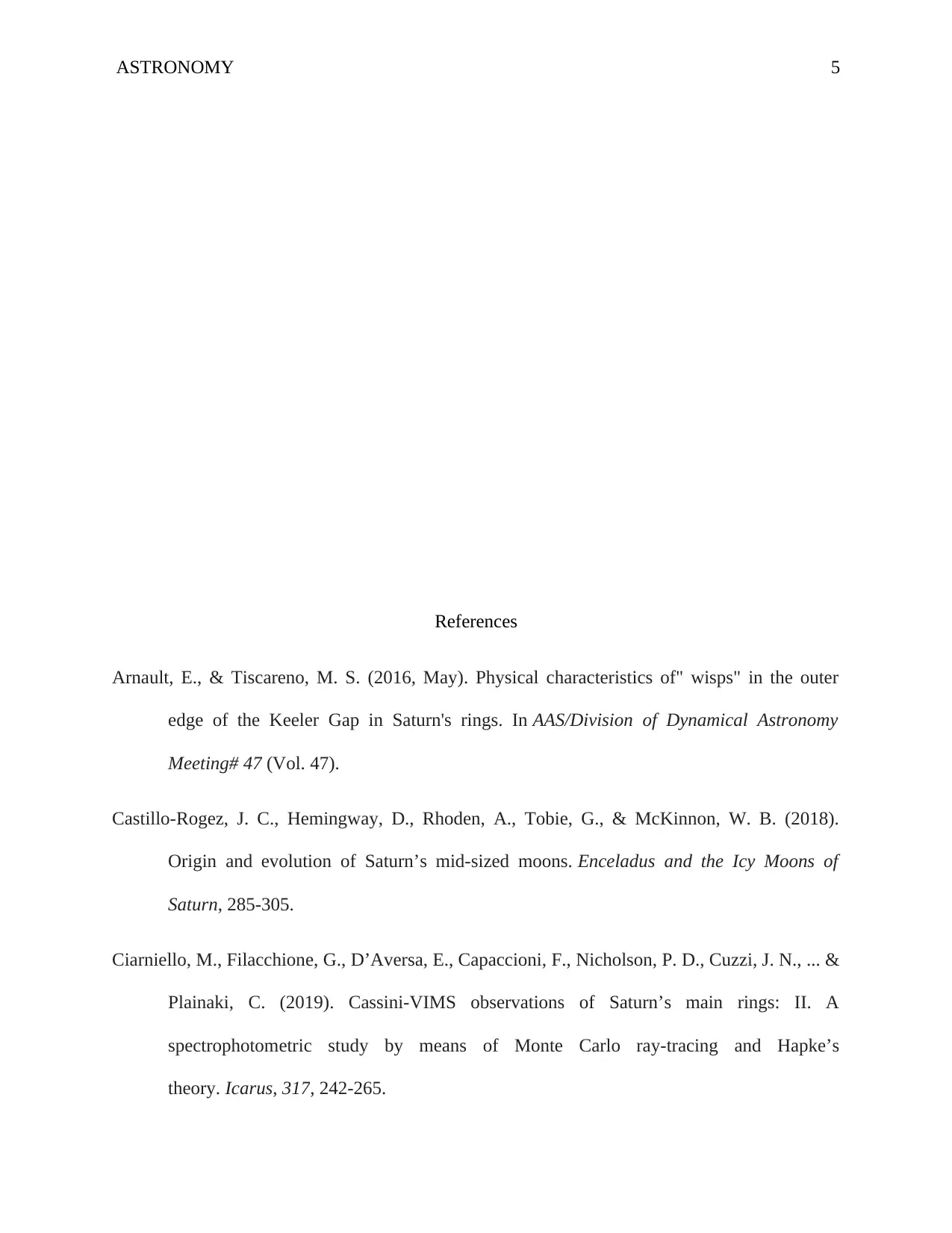
ASTRONOMY 5
References
Arnault, E., & Tiscareno, M. S. (2016, May). Physical characteristics of" wisps" in the outer
edge of the Keeler Gap in Saturn's rings. In AAS/Division of Dynamical Astronomy
Meeting# 47 (Vol. 47).
Castillo-Rogez, J. C., Hemingway, D., Rhoden, A., Tobie, G., & McKinnon, W. B. (2018).
Origin and evolution of Saturn’s mid-sized moons. Enceladus and the Icy Moons of
Saturn, 285-305.
Ciarniello, M., Filacchione, G., D’Aversa, E., Capaccioni, F., Nicholson, P. D., Cuzzi, J. N., ... &
Plainaki, C. (2019). Cassini-VIMS observations of Saturn’s main rings: II. A
spectrophotometric study by means of Monte Carlo ray-tracing and Hapke’s
theory. Icarus, 317, 242-265.
References
Arnault, E., & Tiscareno, M. S. (2016, May). Physical characteristics of" wisps" in the outer
edge of the Keeler Gap in Saturn's rings. In AAS/Division of Dynamical Astronomy
Meeting# 47 (Vol. 47).
Castillo-Rogez, J. C., Hemingway, D., Rhoden, A., Tobie, G., & McKinnon, W. B. (2018).
Origin and evolution of Saturn’s mid-sized moons. Enceladus and the Icy Moons of
Saturn, 285-305.
Ciarniello, M., Filacchione, G., D’Aversa, E., Capaccioni, F., Nicholson, P. D., Cuzzi, J. N., ... &
Plainaki, C. (2019). Cassini-VIMS observations of Saturn’s main rings: II. A
spectrophotometric study by means of Monte Carlo ray-tracing and Hapke’s
theory. Icarus, 317, 242-265.
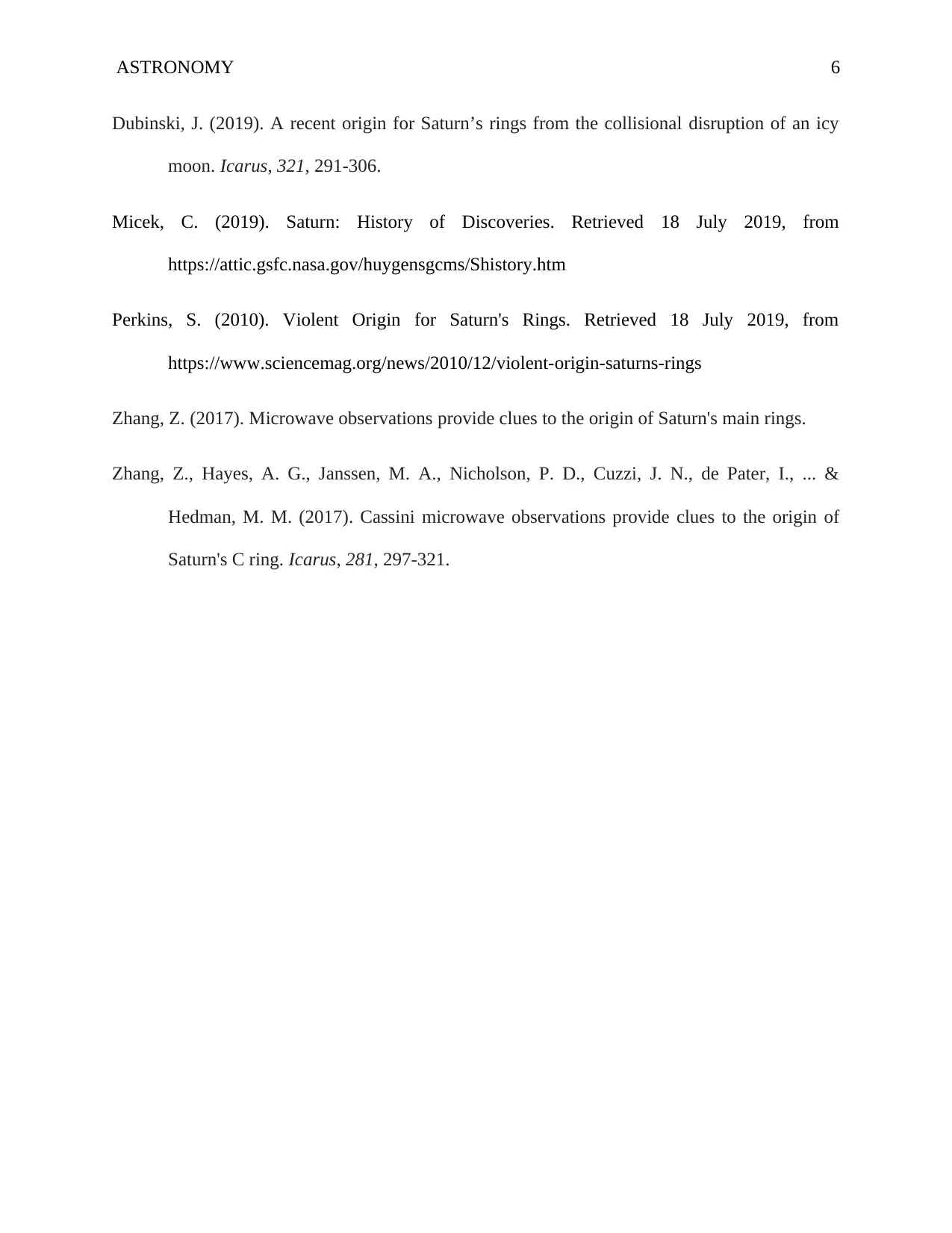
ASTRONOMY 6
Dubinski, J. (2019). A recent origin for Saturn’s rings from the collisional disruption of an icy
moon. Icarus, 321, 291-306.
Micek, C. (2019). Saturn: History of Discoveries. Retrieved 18 July 2019, from
https://attic.gsfc.nasa.gov/huygensgcms/Shistory.htm
Perkins, S. (2010). Violent Origin for Saturn's Rings. Retrieved 18 July 2019, from
https://www.sciencemag.org/news/2010/12/violent-origin-saturns-rings
Zhang, Z. (2017). Microwave observations provide clues to the origin of Saturn's main rings.
Zhang, Z., Hayes, A. G., Janssen, M. A., Nicholson, P. D., Cuzzi, J. N., de Pater, I., ... &
Hedman, M. M. (2017). Cassini microwave observations provide clues to the origin of
Saturn's C ring. Icarus, 281, 297-321.
Dubinski, J. (2019). A recent origin for Saturn’s rings from the collisional disruption of an icy
moon. Icarus, 321, 291-306.
Micek, C. (2019). Saturn: History of Discoveries. Retrieved 18 July 2019, from
https://attic.gsfc.nasa.gov/huygensgcms/Shistory.htm
Perkins, S. (2010). Violent Origin for Saturn's Rings. Retrieved 18 July 2019, from
https://www.sciencemag.org/news/2010/12/violent-origin-saturns-rings
Zhang, Z. (2017). Microwave observations provide clues to the origin of Saturn's main rings.
Zhang, Z., Hayes, A. G., Janssen, M. A., Nicholson, P. D., Cuzzi, J. N., de Pater, I., ... &
Hedman, M. M. (2017). Cassini microwave observations provide clues to the origin of
Saturn's C ring. Icarus, 281, 297-321.
⊘ This is a preview!⊘
Do you want full access?
Subscribe today to unlock all pages.

Trusted by 1+ million students worldwide
1 out of 6
Your All-in-One AI-Powered Toolkit for Academic Success.
+13062052269
info@desklib.com
Available 24*7 on WhatsApp / Email
![[object Object]](/_next/static/media/star-bottom.7253800d.svg)
Unlock your academic potential
Copyright © 2020–2025 A2Z Services. All Rights Reserved. Developed and managed by ZUCOL.


